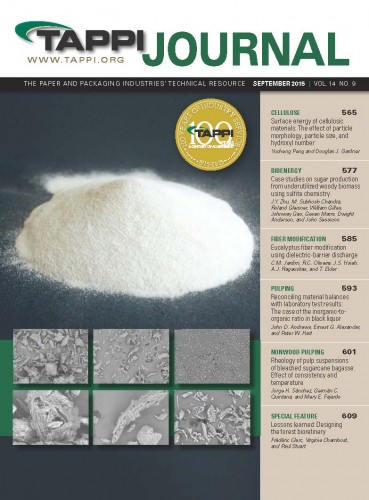Paper by Yucheng Peng and Douglas J. Gardner featured on cover of Tappi Journal Vol. 14

A paper by Dr. Yucheng Peng and Dr. Douglas J. Gardner titled, “Surface energy of cellulosic materials: The effect of particle morphology, particle size, and hydroxyl number,” has been published in the September 2015 edition of TAPPI Journal, Volume 14. The paper is highlighted as a featured paper on the journal’s cover.
Peng is postdoctoral fellow, Department of Materials Science and Engineering, Clemson University, Clemson, SC, USA. Gardner is professor, Advanced Structures and Composites Center, University of Maine, Orono, ME.
Click here to access the paper on TAPPI’s website.
Abstract:
Understanding the surface properties of cellulose materials is important for proper commercial applications. The effect of particle size, particle morphology, and hydroxyl number on the surface energy of three microcrystalline cellulose (MCC) preparations and one nanofibrillated cellulose (NFC) preparation were investigated using inverse gas chromatography at column temperatures ranging from 30ºC to 60ºC. The mean particle sizes for the three MCC samples and the NFC sample were 120.1, 62.3, 13.9, and 9.3 µm. The corresponding dispersion components of surface energy at 30°C were 55.7 ± 0.1, 59.7 ± 1.3, 71.7 ± 1.0, and 57.4 ± 0.3 mJ/m2. MCC samples are agglomerates of small individual cellulose particles. The different particle sizes and morphologies of the three MCC samples resulted in various hydroxyl numbers, which in turn affected their dispersion component of surface energy. Cellulose samples exhibiting a higher hydroxyl number have a higher dispersion component of surface energy. The dispersion component of surface energy of all the cellulose samples decreased linearly with increasing temperature. MCC samples with larger agglomerates had a lower temperature coefficient of dispersion component of surface energy.

Application:
These research results contribute to a better understanding of cellulosic materials with different sizes and morphologies, which exhibit different surface energies. This information should help facilitate product development and manufacturing in the food, pharmaceutical, and composite material industries.
Learn more at: http://www.tappi.org/Bookstore/Technical-Papers/Journal-Articles/TAPPI-JOURNAL/Archives/2015/September/TABLE-OF-CONTENTS/15sep565.aspx
